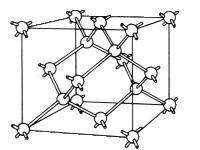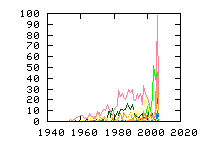« Previous
1
Next »
(8 hits, 1/1)
Showing
10, 25, 50, 100, 500, 1000, all papers per page.
Sort by:
last publication date,
older publication date,
last update date.
- 1. Phys. Rev. B 74, 235201 (2006) , “Annealing of multivacancy defects in 4H-SiC”, W. E. Carlos, N. Y. Garces, E. R. Glaser, and M. A. FantonThe annealing behavior of defects observed in electron paramagnetic resonance (EPR) and photoluminescence (PL) is discussed. We consider the divacancy (the P6/P7 EPR centers) and a previously unreported EPR center that we suggest is a VC-VSi-VC... (Read more)
- 2. Phys. Rev. B 71, 115204 (2005) , “Electron Spin Resonance Study of Paramagnetic Centers in Neutron-Irradiated Heat-Treated Silicon”, D. Pierreux and A. StesmansElectron spin resonance (ESR) was used to study neutron-induced defects in silicon as functions of anneal temperature Tan. For Tan below 200 °C, the ESR response is dominated by the Si-P3 and Si-P6 spectra, as observed before. At Tan=200 ... (Read more)
- 3. Physica B 302-303, 233-238 (2001) , “Complexes of Gold and Platinum with Hydrogen in Silicon”, P. T. Huy and C. A. J. AmmerlaanThree centers that involve gold or platinum and hydrogen have been observed in n-type hydrogenated silicon by electron paramagnetic resonance. The first two centers, labeled Si-NL63 and Si-NL64, were detected in the gold-doped samples revealing hyperfine interaction with two gold atoms for the... (Read more)
- 4. Mater. Sci. Eng. B 71, 263 (2000) , “Comparison of Electronic Structure and Properties of Hydrogen-Associated and Thermal Double Donors in Silicon”, S. Zh. Tokmoldin, B. N. Mukashev, Kh. A. Abdullin, Yu. V. Gorelkinskii and B. PajotInfrared (IR) and electron paramagnetic resonance (EPR) studies of quenching-dependent hydrogen-related double donor (HDD) formed in proton-implanted n-Si and p-Si upon annealing above 300°C were carried out. IR data taken at liquid He and N2 reveal that quenching-dependent IR absorption lines... (Read more)
- 5. Phys. Rev. B 61, 2657 (2000) , “Divacancy-Tin Complexes in Electron-Irradiated Silicon Studied by EPR”, M. Fanciulli, J. R. Byberg.n- and p-type float-zone silicon containing 1018-cm-3 tin were irradiated with 2 MeV electrons to a dose of 1018 cm-2 and subsequently examined by electron paramagnetic resonance (EPR). The p-type material yields only the well-known Si-G29 signal due to... (Read more)
- 6. Phys. Rev. B 61, 1918 (2000) , “EPR investigation of manganese clusters in silicon”, J. Martin, J. Wedekind, H. Vollmer, and R. LabuschManganese centers were investigated in silicon specimens with initial doping concentrations between 1.5?1015 P cm-3 and 6?1015 B cm-3. All known Mn centers could be observed but the cluster Mni3Mni was missing in highly-boron-doped... (Read more)
- 7. phys. stat. sol. (b) 221, 625-631 (2000) , “Identification of the Gold-Lithium Defect L1 in Silicon with the Trigonal Centre Au2--(Li+)3 by Electrical, Optical and Magnetic Resonance Spectroscopy”, B. Langhanki, J. ?M. SpaethN-type silicon doped with gold and lithium was investigated by Electron Paramagnetic Resonance (EPR) and Deep Level Transient Spectroscopy (DLTS), using two sets of samples with different defect concentrations of both gold and lithium. Photoluminescence (PL) on both sets of samples allowed to... (Read more)
- 8. Phys. Rev. B 9, 4351-4361 (1974) , “EPR study of defects in neutron-irradiated silicon: Quenched-in alignment under <110>-uniaxial stress”, Young-Hoon Lee and James W. CorbettThe stress effect in an EPR study is first treated rigorously in terms of the piezospectroscopic tensor, taking account of the local symmetry of a defect. It is found that the degree of alignment (n?/n?) provides incisive information on the structure of a defect; in general, a... (Read more)
« Previous
1
Next »
(8 hits, 1/1)
Showing
10, 25, 50, 100, 500, 1000, all papers per page.
Sort by:
last publication date,
older publication date,
last update date.
All papers (3399)
Updated at 2010-07-20 16:50:39
Updated at 2010-07-20 16:50:39
(view as: tree
,
cloud
)
| 1329 | untagged |
Materials
(111 tags)
Others(101 tags)
Technique
(46 tags)
Details
(591 tags)
Bond(35 tags)
Defect(interstitial)(18 tags)
Defect(vacancy)(15 tags)
Defect-type(19 tags)
Element(65 tags)
Energy(8 tags)
Isotope(56 tags)
Label(303 tags)
Sample(17 tags)
Spin(8 tags)
Symmetry(15 tags)

